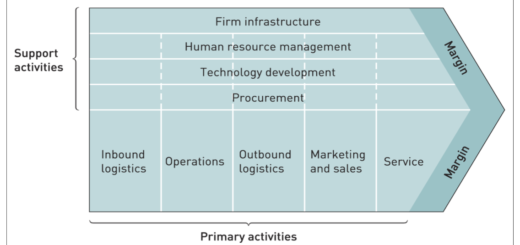Strategy an Introduction
Strategy refers to a plan or course of action designed to achieve a specific goal or set of goals. It encompasses the overall approach an organization takes to achieve its objectives, taking into account its strengths and weaknesses, available resources, and external factors such as competition and market conditions. A good strategy should be flexible, adapting to changes in the environment while still remaining focused on achieving its objectives.
In business, strategies are often developed at the highest levels of an organization and can encompass a wide range of initiatives, from marketing and product development to financial planning and organizational structure.
Here are a few definitions from notable scholars and thinkers in the field of strategy:
- Michael Porter, a Harvard Business School professor, defines strategy as “the creation of a unique and valuable position, involving a different set of activities.”
- Henry Mintzberg, a McGill University professor, defines strategy as “a pattern in a stream of decisions.”
- Sun Tzu, an ancient Chinese general and military strategist, defined strategy as “the art of war” and wrote that it involves “the employment of troops” and “the planning of campaigns.”
- John Boyd, a military strategist, defined strategy as “a pattern of actions and decisions designed to achieve an end state or objective.”
Contents
- 1 History of Strategy:
- 2 The Goal of Strategy for a Firm
- 3 Key Elements of Organisation Strategy:
- 4 Strategic Management as a process
- 5 Branches/Component of Strategy:
- 6 Level of Strategy:
- 7 Strategic Management as; Art, Craft and Science
- 8 ‘Prescriptive (Deliberate or Intended) & ‘Emergent strategy
- 9 Mintzberg Forms of Strategy
History of Strategy:
The concept of strategy has its roots in ancient military history. The earliest recorded instances of strategy can be traced back to Sun Tzu’s “The Art of War,” a treatise on military strategy written in ancient China. The text outlines the principles and tactics for successfully conducting war and is considered one of the seminal works on the subject.
Over time, the concept of strategy has evolved and expanded to encompass a wide range of fields and disciplines, including business, politics, and sports. In the 19th and 20th centuries, the military strategy became increasingly sophisticated, with the development of new technologies, tactics, and philosophies of warfare.
In the business world, the concept of strategy was popularized in the 1950s and 1960s by prominent management consultants such as Peter Drucker and Michael Porter. They emphasized the importance of a clear strategy for success in competitive markets and developed frameworks for analyzing and shaping a company’s competitive position.
Today, the concept of strategy is widely used and applied in a variety of fields, and there is a rich body of research and literature on the subject. The field continues to evolve and adapt to changing circumstances, and new theories and approaches to strategy are constantly being developed and tested.
The Goal of Strategy for a Firm
The ultimate goals of strategy for a firm can include:
- Increased market share: A firm aims to increase its market share by attracting more customers and increasing its sales.
- Higher profits: The goal of many firms is to maximize their profits by reducing costs, increasing revenue, and improving efficiency.
- Long-term financial growth: A firm may aim to achieve long-term financial growth by expanding its operations, entering new markets, and investing in new products or services.
- Customer satisfaction: A firm may aim to increase customer satisfaction by delivering high-quality products or services, providing excellent customer service, and addressing customer needs and preferences.
- Employee satisfaction: A firm may aim to increase employee satisfaction by offering competitive compensation packages, providing opportunities for career advancement, and creating a positive work environment.
- Corporate social responsibility: A firm may aim to address social and environmental issues by engaging in practices that are environmentally friendly and socially responsible.
- Innovation: A firm may aim to maintain a competitive advantage by continually innovating its products, services, and processes.
These goals are not mutually exclusive, and a firm’s strategy may aim to achieve several of these objectives simultaneously. The ultimate goal of the strategy is to create value for the firm’s stakeholders and to ensure the long-term success of the firm.
Key Elements of Organisation Strategy:
Policies, strategic tactics, and control are interrelated components of an organization’s overall strategy.
- Policies: Policies are general guidelines or rules that govern the behavior of individuals within an organization. They help to ensure that everyone is working towards the same goals and that decisions are consistent and in line with the organization’s values. Policies provide a framework for decision making and help to ensure that the organization operates in a predictable and consistent manner.
- Strategic tactics: Strategic tactics are specific actions or steps taken to achieve the goals and objectives set out in the organization’s strategy. They are the means by which the organization will realize its desired outcomes and may include things like expanding into new markets, investing in new technology, or entering into partnerships with other organizations.
- Control: Control is the process of monitoring and adjusting the implementation of the organization’s strategy to ensure that it is on track and achieving its desired outcomes. This may include setting performance targets, monitoring progress, and taking corrective action if necessary. Control helps to ensure that the organization is operating efficiently and effectively and that any deviations from the plan are identified and addressed in a timely manner.
Together, policies, strategic tactics, and control form a system that enables an organization to achieve its goals and objectives. Effective policies provide the framework for consistent decision-making, while strategic tactics provide the means to achieve desired outcomes. Control helps to ensure that the organization is operating efficiently and effectively and that the strategy is on track to achieve its desired outcomes.
Strategic Management as a process
Core Areas of Strategic Management are:
- Strategic Analysis (Situation/Environmental Analysis): This step involves conducting a comprehensive analysis of the organization’s internal and external environment to identify its strengths, weaknesses, opportunities, and threats (SWOT analysis). This information is used to identify the organization’s current position and the challenges it faces.
- Strategic Development (Formulation of Strategy): Based on the results of the situation analysis, the organization formulates a strategic plan that outlines its desired direction and the actions it will take to achieve its goals. This may include identifying new markets to enter, developing new products, or improving operational efficiency.
- Strategy Implementation: This step involves putting the strategic plan into action. This may include reorganizing the organization, investing in new technology, or launching new products. Effective implementation requires close coordination between different parts of the organization and the allocation of sufficient resources.
Branches/Component of Strategy:
strategy can also be understood through the lens of context, content, and process:
- Context: This refers to the external and internal factors that shape the organization’s environment, such as market trends, technological advancements, and the competitive landscape. Understanding the context in which an organization operates is crucial for developing effective strategies.
- Content: This refers to the specific decisions and actions that an organization takes in order to achieve its goals. This can include decisions on market position, product development, and resource allocation. The content of a strategy defines the organization’s approach to competing in its environment and achieving its goals.
- Process: This refers to the systematic and ongoing approach to strategy development and implementation. This can include steps such as situation analysis, strategy formulation, implementation, and evaluation. The process of strategy helps organizations to continuously review and refine their strategies in response to changes in the context and to ensure that their strategies are achieving their desired outcomes.
Context, content, and process are interrelated and important elements of strategy. By considering these elements in a holistic manner, organizations can develop and implement strategies that are effective in achieving their goals and adapting to changes in their environment.
Level of Strategy:
Strategy can be applied at different levels within an organization, including:
- Corporate level: Corporate level strategy deals with the overall direction of the organization and the allocation of resources across its different business units or divisions. It defines the organization’s vision, mission, and objectives and guides decision making on issues such as mergers and acquisitions, divestitures, and portfolio management.
- Business level: Business level strategy focuses on the competitive position of an individual business unit or division. It deals with issues such as market positioning, product development, and competitive advantage. Business level strategy helps organizations to compete effectively in their target markets and to create value for their customers.
- Functional level: Functional level strategy deals with the specific activities and processes within an organization, such as marketing, finance, and operations. It defines how each function will support the organization’s overall strategy and achieve its goals. Functional level strategies are developed and implemented by the various departments within an organization, and they should align with the overall corporate and business strategies.
- Operating level: Operating level strategy deals with the day-to-day activities and operations of the organization. It involves the development of policies, procedures, and programs to support the implementation of the overall corporate, business, and functional level strategies.
In conclusion, strategy can be applied at different levels within an organization, including the corporate, business, functional, and operating levels. Effective strategic management requires a holistic approach that considers the organization’s overall direction, the competitive position of its individual business units, and the activities and processes that support its operations. Each level of strategy should be aligned with the others to ensure that the organization is working towards its common goals and objectives.
Strategic Management as; Art, Craft and Science
Strategic management can be seen as a combination of art, craft, and science.
Art: Strategic management involves creative problem-solving, intuition, and subjective decision-making. It requires a deep understanding of the organization’s environment, industry, and stakeholders, as well as the ability to envision the future and identify new opportunities. In this sense, strategic management can be seen as an art form, as it involves using creativity and imagination to develop innovative solutions to complex problems.
Craft: Strategic management also requires technical skills and practical knowledge, just like a craft. For example, strategic managers must have a deep understanding of the tools and techniques used to analyze data, assess market trends, and evaluate the organization’s strengths and weaknesses. They must also be able to develop and implement plans effectively, which requires project management skills and attention to detail.
Science: Finally, strategic management can be seen as a science because it involves the systematic application of theories, models, and frameworks to understand and solve problems. Strategic managers use data, research, and analysis to inform their decisions and develop evidence-based strategies. They also use rigorous methods to test and evaluate their strategies, and to measure the impact of their decisions over time.
In conclusion, strategic management draws on elements of art, craft, and science, as it requires a combination of creative problem-solving, technical skills, and scientific rigor.
‘Prescriptive (Deliberate or Intended) & ‘Emergent strategy
Prescriptive (or deliberate) strategy refers to a strategic approach that is carefully planned and intentionally designed to achieve specific goals and objectives. In this type of strategy, the organization has a clear understanding of where it wants to go and has put in place a roadmap to get there.
In a prescriptive strategy, the organization starts by defining its mission, vision, and values, and then sets specific, measurable, and achievable goals to align with these. The organization then develops a detailed plan that outlines the steps it needs to take to achieve its goals, taking into account the internal and external factors that will impact its progress.
Emergent strategy is a type of strategy that emerges over time as a result of the organization’s ongoing experimentation and adaptation to its environment. It is a bottom-up process that involves learning from experience and adapting to changing circumstances in real-time, rather than following a pre-determined plan.
Emergent strategies tend to be less formal and structured than prescriptive strategies, and are often developed and refined through a process of trial and error. They are characterized by flexibility, adaptability, and a willingness to experiment and take risks.
Mintzberg Forms of Strategy
- Intended strategy
- Expression of desired strategic direction deliberately formulated or planned by managers
- Unrealized strategy
- Frequently strategies do not come about in practice
- Plans are unworkable
- Environment changes
- Influential stakeholders do not agree with the plan
- Frequently strategies do not come about in practice
- Emergent strategy
- Comes about through everyday routines, activities, and processes
- Realized strategy
- The strategy actually being followed by an organization in practice





